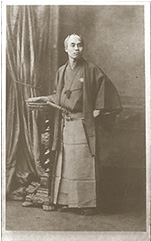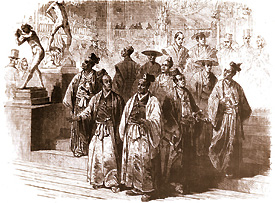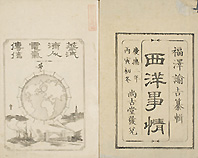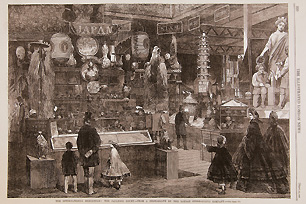Yukichi Fukuzawa Goes to the Expo

The World Exposition is now held in Shanghai (as of October 15, 2010 at the time of the publication of Juku vol.268). The first Expo in Japan was held 40 years ago in Osaka in 1970. And even more than a hundred years ago from that time, Yukichi Fukuzawa who visited the London Exposition in 1862 introduced the open system for cultural exchange in his work Seiyo Jijo ("Things Western"), and stimulated young people who were to lead "bunmei-kaika"(cultural enlightenment) at a time before the Meiji Restoration.
Fukuzawa's Seiyo Jijo explains details of the London Exposition

From "The Illustrated London News"
The World Exposition held in Shanghai, China will close on October 31. Just as Japan took advantage of the Tokyo Olympic Games and the Osaka Exposition to make a dramatic leap forward as a country, China is likely to strengthen its national power even more through the Beijing Olympic Games and Shanghai Exposition.
Tracing back the history of World Expositions, national expositions became popular in Europe and the U.S., which developed beyond national borders to international expositions that showed products from several countries. In 1851, the first World Exposition was held in London. It was a full-scale exposition that was held for over 5 months. It was then held in New York and Paris, and was held again in London in 1862, and this is the exposition Yukichi Fukuzawa visited as a member of the Tokugawa government's mission to Europe.
Based on this experience, he explains about museums and expositions in his work Seiyo Jijo which was published in 1866. Although mentioning that museums are meaningful, and what once was a new technology "can now be worn-out, and a new gadget of yesterday can be a useless thing today". "Therefore, in large cities of the West, a convention of products is held once every few years, which is announced to the world, and specialty products, useful machines, antiques and rare items from each country are gathered to show to people from around the world. This is called an exposition." He explains accurately the purpose of holding an international exposition that enables to introduce widely new technologies and products.
Also referring to the London Exposition he visited himself, he wrote that "an exposition was held in London in 1862, and more than 40 to 50 thousand people visited daily", mentioning that there were so many visitors. He also explains that world expositions are very meaningful for international exchange of technological knowledge, and wrote that "the point of holding expositions is to teach and learn from each other, and to take advantage of each other's strengths. It is like trading intelligence and ideas."

Seiyo Jijo was a bestseller at the time and made a significant influence on people just days before the Meiji Restoration, as it introduced different systems of the government such as democracy and monarchy, and the parliamentary system. At the same time, the introduction of expositions that are held across national borders must have been a surprise and a great stimulation for people who experienced a long period of national isolation. In fact, Japan officially exhibited for the first time in the second Paris Exposition that was held in 1867, just a year after this book was published. The Tokugawa government as well as the Satsuma and Saga Domains held exhibitions and displayed pottery and lacquerware, which lead to Japanism in Europe.
"This is interesting, this should be the perfect material to prepare for civilization"

From "The Illustrated London News"
In Fukuzawa Zenshu Shogen ("Foreword to the Collected Works of Fukuzawa") published in 1897, Fukuzawa comments on his own writing Seiyo Jijo to be the "most widely read book of all my works and the book that gained the most attention".
In the Foreword, he looks back at the experience traveling with the mission about 35 years ago, and writes that learning about political parties in England, how he was surprised at the difference from Japan which at the time forbade to form "cliques", and how he was impressed to see the postal service in France because once you put a stamp on a letter, it is delivered as if on its own. At the same time, he mentioned that "there was nothing that didn't look new such as (hospitals, museums and) expositions, and learning about their origins and functions, there was nothing not amazing".
He also made an interesting comment in the Foreword about Seiyo Jijo being read by a great number of people and "dominated the Japanese society".
Leading members of various domains who accelerated the Meiji Restoration were talented, and having been educated under the spirit of Bushido (the way of Samurai), they were high-spirited, but were ignorant of studies of the East, and from the Confucian point of view, "we must say that they are illiterate". However, those ignorant of the studies of Confucianism were the ones who "made the great achievement of the Restoration" and when they sought to "open the country for a new civilization", they came across Seiyo Jijo. This book became an important source for them. "This is interesting, this should be the perfect material to prepare for civilization".
Fukuzawa himself analyzes that this spread by word of mouth among those in the same spirit, and the book probably acted as a bible for people seeking cultural enlightenment.
What was the "perfect material to prepare for civilization" was primarily the form and system of Western politics, but also the open way of thinking of holding a world exposition to provide information and to learn from each other must have stimulated young people of the time. In other words, Seiyo Jijo was an irreplaceable book that prompted the Meiji Restoration and accelerated cultural enlightenment.
100 years after Japan started to take the path of modernization, having experienced the defeat in war and high economic growth, the World Exposition was finally held in our country in 1970. Another 40 years have passed, and this year, the Shanghai Exposition is held spectacularly in China, home to Confucianism which high-spirited people of the Restoration overcame to open their eyes towards the West.
| Year Events | |
|---|---|
| 1851 | The first World Exposition is held in London |
| 1862 | The second World Exposition is held in London *Yukichi Fukuzawa visits the exposition |
| 1866 | Publication of Seiyo Jijo |
| 1867 | The Paris Exposition
*The Tokugawa government, Satsuma and Saga Domains hold exhibitions
Meiji Restoration (Tokugawa government turns over its political power to the emperor) |
| 1868 | Start of the Meiji Era |
| 1897 | Publication of Fukuzawa Zenshu Shogen ("Foreword to the Collected Works of Fukuzawa") |
| ・ ・ ・ |
|
| 1970 | Osaka Exposition |
| 2010 | Shanghai Exposition |
Photographs that are marked with * are image material preserved by the Fukuzawa Memorial Center for Modern Japanese Studies
